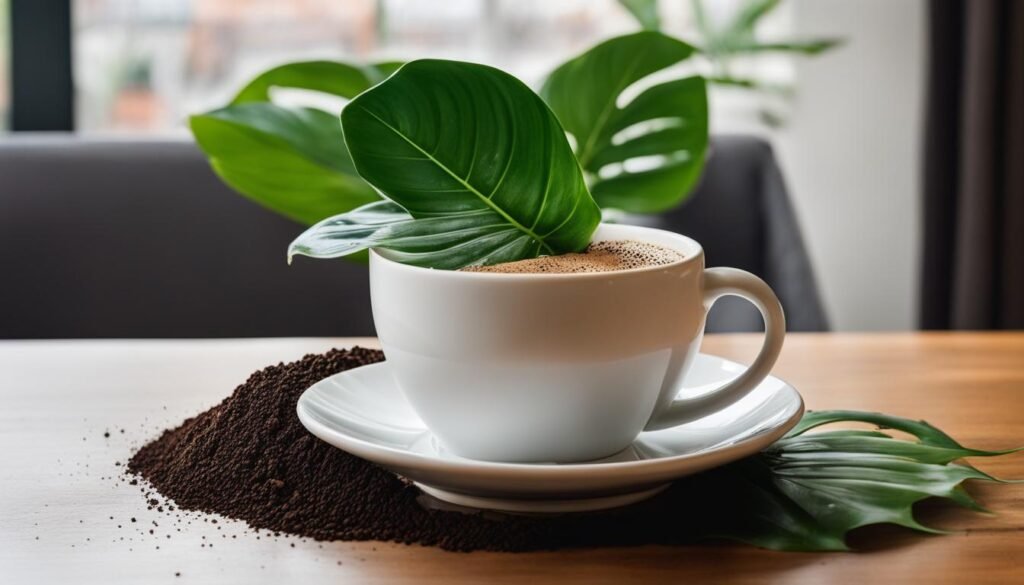When it comes to caring for our beloved Monstera plants, we all want to give them the best possible care. From finding the perfect spot in our homes to providing the right amount of sunlight and water, every little detail matters. But what about using coffee grounds as a natural fertilizer? Are our Monstera plants fans of this common household waste? Let’s dive into the world of monstera plant care, soil requirements, and fertilizing tips to find out if coffee grounds are a suitable option.
Key Takeaways:
- Monstera plants can benefit from coffee grounds in moderation.
- Using coffee grounds sparingly helps avoid attracting fungus and gnats.
- Monstera Deliciosa, Monstera Adansonii, Monstera Obliqua, and Monstera Borsigiana are types of Monstera that can be fertilized with coffee grounds.
- Adding coffee grounds to the soil every 4 to 6 weeks can provide essential nutrients and improve soil drainage.
- Coffee grounds are mildly acidic and can help maintain an acidic soil pH.
Types of Monstera That Can Be Fertilized with Coffee Grounds
If you’re wondering which types of Monstera plants can benefit from coffee grounds, you’re in the right place! There are a few specific varieties that can thrive with the addition of coffee grounds to their soil.
The first type is Monstera Deliciosa, also known as the Swiss Cheese Plant. This popular variety with its iconic fenestrated leaves can benefit from the organic matter and nutrient content provided by coffee grounds.
Another variety is Monstera Adansonii, commonly known as the Swiss Cheese Vine. Its delicate, holey leaves can benefit from the nutrients present in coffee grounds, promoting healthy growth and foliage.
Monstera Obliqua and Monstera Borsigiana are two more types of Monstera that can be fertilized with coffee grounds. These varieties, known for their unique leaf shapes and patterns, can thrive with the added nutrients and improved soil structure coffee grounds offer.
Routine for Fertilizing Monstera with Coffee Grounds
Fertilizing your Monstera with coffee grounds can be a beneficial practice, but it’s important to establish a proper routine to ensure optimal results. Here, we will outline a simple and effective method for using coffee grounds as a natural fertilizer for your Monstera plants.
1. Prepare the coffee grounds
Before adding coffee grounds to your Monstera’s soil, it’s important to prepare them properly to avoid any potential issues. Begin by drying out the coffee grounds to prevent the growth of mold or fungus. You can spread them on a tray or parchment paper and leave them to air dry for a few days. Once dry, you can either use them directly or slightly dampen them before application.
2. Choose your method of application
There are two primary methods for incorporating coffee grounds into your Monstera’s soil. The first method involves burying a small cloth bag filled with dry or slightly damp coffee grounds in the soil near one side of the plant’s pot. This allows the coffee grounds to gradually release their nutrients into the soil over time. The second method involves mixing the coffee grounds with compost or other organic material, such as coconut coir or peat moss, to dilute them before adding them to the potting mix. This ensures a more balanced distribution of nutrients throughout the soil.
3. Monitor and adjust as needed
After applying the coffee grounds, it’s essential to monitor the soil pH levels and observe the plant’s response. Coffee grounds are mildly acidic, so it’s crucial to ensure that the soil’s pH remains within the optimal range for Monstera plants, which is slightly acidic to neutral. If you notice any signs of fungal growth or excessive moisture retention, it may be necessary to adjust the amount of coffee grounds or frequency of application to prevent these issues.
Fertilizing your Monstera with coffee grounds can provide a natural and cost-effective way to nourish your plant. By following a proper routine and paying attention to the plant’s needs, you can enjoy the benefits of coffee grounds as a sustainable fertilizer option for your Monstera plant.
Soil pH and Acidity Levels of Coffee Grounds

Coffee grounds are known for their mildly acidic nature, with a pH ranging from 6.5 to 6.8. This moderate acidity can have both positive and negative effects on the soil when used as a fertilizer for Monstera plants.
It is important to be mindful of the soil pH levels when adding coffee grounds to the soil. While a small handful of coffee grounds is unlikely to harm an established, healthy Monstera plant, excessive use can potentially alter the pH value of the soil. This alteration can inhibit the growth and development of certain plants, including Monstera. Therefore, it is crucial to use coffee grounds in moderation and monitor the plant’s response.
Nevertheless, the use of coffee grounds as a natural fertilizer can be beneficial for Monstera plants. Along with contributing essential nutrients like nitrogen, phosphorus, and potassium, the acidity of coffee grounds can help maintain an ideal soil pH for these plants. When used appropriately, coffee grounds can improve soil structure, enhance nutrient availability, and support healthy foliage growth in Monstera plants.
Benefits of Fertilizing Monstera with Coffee Grounds

If you’re looking for an organic fertilizer for your Monstera plants, coffee grounds can be a great option. They offer several benefits that can contribute to the health and growth of your Monstera. Here are a few reasons why fertilizing your Monstera with coffee grounds can be advantageous:
- Rich in nutrients: Coffee grounds are a natural source of essential nutrients like nitrogen, phosphorus, and potassium. These nutrients are vital for the development of healthy foliage and overall plant growth.
- Natural fertilizer: Using coffee grounds as a fertilizer is an eco-friendly choice. It reduces waste by repurposing a byproduct, making it a sustainable option for nourishing your Monstera plants.
- Improved soil structure: Coffee grounds can help improve the structure of the soil. They enhance soil aeration and drainage, which promotes root health and prevents waterlogging.
When using coffee grounds as a fertilizer, it’s important to remember that moderation is key. Too much coffee grounds can lead to excess moisture retention and attract pests. It’s always advisable to monitor your plants’ progress and adjust the amount of coffee grounds accordingly. By incorporating coffee grounds into your fertilizing routine, you can provide your Monstera plants with the nutrients they need while also promoting sustainability.
Conclusion
In summary, when it comes to using coffee grounds for plants, including Monstera plants, it’s important to exercise caution and moderation. While coffee grounds can offer some benefits, such as providing essential nutrients and improving soil structure, their direct application to Monstera plants can attract fungus and pests, potentially causing harm.
Our recommendation is to utilize coffee grounds in compost or as part of a balanced fertilizing routine. By diluting the grounds with other organic materials, we can minimize the risk of attracting unwanted pests and ensure the nutrients are evenly distributed throughout the soil.
Remember, coffee grounds are just one option among many for fertilizing Monstera plants. Before deciding to use coffee grounds, it’s essential to consider the specific needs of your plant and weigh the potential risks and benefits. By doing so, you can make an informed decision about the best approach to nourish your Monstera and help it thrive.
FAQ
Does Monstera Like Coffee Grounds?
Monstera plants can benefit from coffee grounds in moderation. Coffee grounds provide essential nutrients like nitrogen and potassium. However, it’s important to use coffee grounds sparingly to avoid attracting fungus and gnats and to prevent the soil from retaining too much moisture.
Which types of Monstera can be fertilized with coffee grounds?
Monstera Deliciosa, Monstera Adansonii, Monstera Obliqua, and Monstera Borsigiana are types of Monstera that can benefit from coffee grounds. Each variety has its own specific nutrient requirements and can benefit from the organic matter and nutrient content provided by coffee grounds.
What is the routine for fertilizing Monstera with coffee grounds?
To fertilize Monstera with coffee grounds, a small cloth bag filled with dry or slightly damp coffee grounds can be buried in the soil near one side of the Monstera’s pot. Coffee grounds can also be mixed with compost or other organic material to dilute them before adding them to the potting mix. It’s important to monitor the soil pH levels and look out for signs of fungal growth.
What are the soil pH and acidity levels of coffee grounds?
Coffee grounds are mildly acidic with a pH of 6.5 to 6.8. While they are not strongly acidic, adding large amounts of coffee grounds to soil is not recommended as it can affect the pH value and inhibit growth in some plants. However, a small handful of coffee grounds should not harm an established, healthy Monstera plant.
What are the benefits of fertilizing Monstera with coffee grounds?
Fertilizing Monstera with coffee grounds can provide several benefits. Coffee grounds are rich in essential nutrients like nitrogen, phosphorus, and potassium, which promote healthy foliage growth and overall plant health. They can act as a natural fertilizer for Monstera plants and improve soil structure. Using coffee grounds as a natural fertilizer is an inexpensive and easily available option.
Should I use coffee grounds for Monstera plants?
While coffee grounds can provide some nutrients and improve soil structure, they should be used in moderation and with caution. Direct application of coffee grounds to Monstera plants can attract fungus and pests, leading to potential harm to the plant. It is recommended to use coffee grounds in compost or as a part of a balanced fertilizing routine.

Leave a Reply